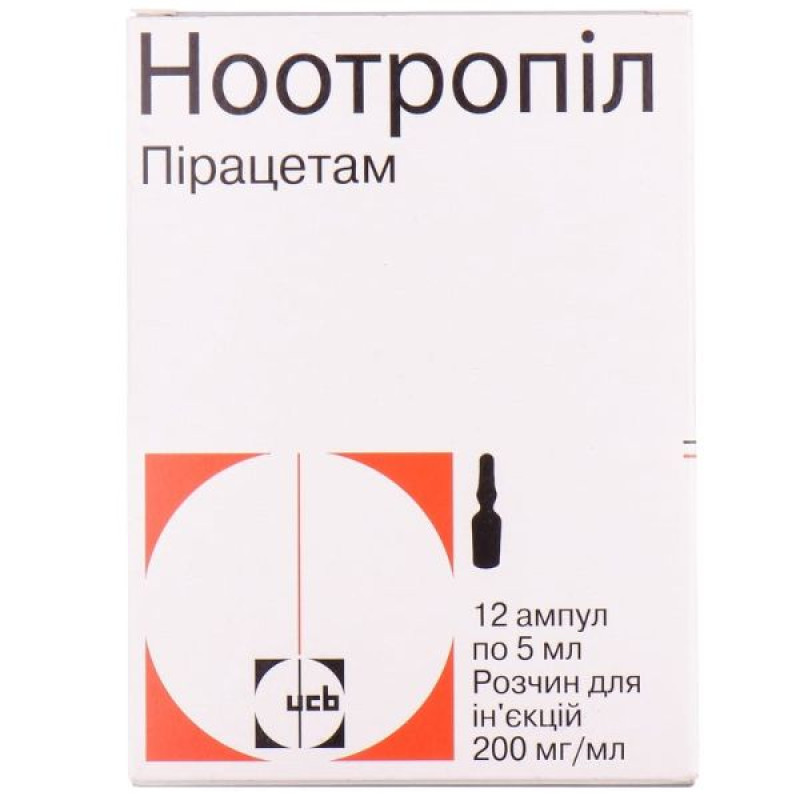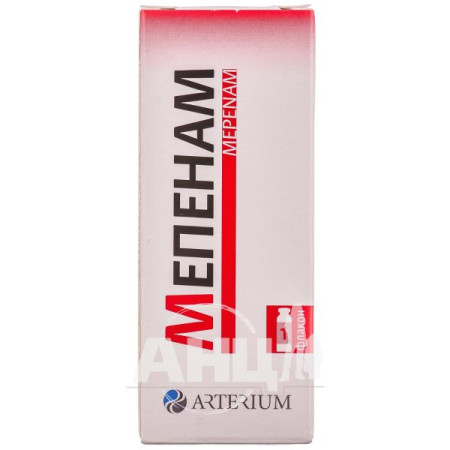Nootropil solution for injection 20% ampoule 5 ml No. 12

Pharmacological properties
Pharmacodynamics. The active component of the drug is piracetam, a cyclic derivative of GABA. Piracetam is a nootropic agent that acts on the brain, improving cognitive (cognitive) functions, such as learning ability, memory, attention, and mental performance. There are probably several mechanisms of the drug's effect on the CNS: changing the speed of propagation of excitation in the brain; enhancing metabolic processes in nerve cells; improving microcirculation by influencing the rheological characteristics of the blood, without causing a vasodilator effect. Improves connections between the cerebral hemispheres and synaptic conduction in neocortical structures. After prolonged use of the drug in patients with reduced brain function, improvement in cognitive functions and attention are noted. These changes are objectively recorded on the EEG (strengthening of α- and β-rhythms of the brain and weakening of δ-rhythms). Piracetam inhibits platelet aggregation and restores the elasticity of the erythrocyte membrane, reduces erythrocyte adhesion. At a dose of 9.6 g, it reduces the level of fibrinogen and von Willebrand factor by 30-40% and prolongs bleeding time. Piracetam has a protective and restorative effect in impaired brain function due to hypoxia, intoxication, and electropulse therapy. Piracetam reduces the severity and duration of vestibular nystagmus, and as a monotherapy is effective in the treatment of cortical myoclonus.
Pharmacokinetics. C max after i / v administration is reached in the blood after 30 min, and in the cerebrospinal fluid - after 5 h and is 40-60 μg / ml. The volume of distribution of piracetam is almost 0.6 l / kg of body weight. T ½ of the drug from blood plasma is 4-5 h and, respectively, 8.5 h - from the cerebrospinal fluid. This period may be prolonged in renal failure. It does not bind to blood plasma proteins, is not metabolized in the body. 80-100% of piracetam is excreted by the kidneys unchanged by glomerular filtration. The renal clearance of piracetam in healthy volunteers is 86 ml / min. The pharmacokinetics of piracetam does not change in patients with liver failure. Piracetam penetrates the blood-brain barrier and the placental barrier and membranes used in hemodialysis. Animal studies have shown that piracetam selectively accumulates in the tissues of the cerebral cortex, mainly in the frontal, parietal and occipital zones, the cerebellum and the basal ganglia.
Indication
adults:
symptomatic treatment of psychoorganic syndrome, which is accompanied by memory loss, dizziness, decreased concentration of attention; treatment of dizziness and associated balance disorders, with the exception of dizziness of vasomotor and mental origin; treatment of cortical myoclonus as a monodrug or as part of complex therapy; as part of complex therapy of sickle cell anemia to reduce the manifestations of vaso-occlusive crisis.children:
treatment of dyslexia in children over 8 years of age in combination with other appropriate methods, including speech therapy; treatment of cortical myoclonus as a monotherapy or as part of complex therapy; as part of complex therapy of sickle cell anemia in children over 3 years of age to reduce the manifestations of vaso-occlusive crisis.Application
The drug in the form of an injection solution is used in acute cases or when it is impossible to use oral forms of piracetam. For adults, the daily dose is 30-160 mg/kg of body weight (multiplicity of application - 2-3 times a day).
The drug is administered intravenously (injected slowly, over several minutes), starting with 2-4 g and quickly increasing the dose to 4-6 g/day. After the condition improves, oral administration is switched to. In the form of tablets, capsules and solution for oral administration, the drug is taken orally. The duration of treatment and the selection of an individual dose depend on the severity of the patient's condition and the speed of the reverse dynamics of the clinical picture of the disease.
Treatment of psychoorganic syndrome
The recommended daily dose is 2.4-4.8 g. Usually the dose is divided into 2-3 doses.
Treatment of cortical myoclonus
The initial daily dose is usually 7.2 g, which is increased to 24 g/day within 3-4 days. The daily dose is divided into 3-4 doses (2-3 injections for the injection solution). If the therapeutic effect is weak or absent, continue to use the drug at the same dose for up to 7 days. If during this period no one has felt the desired therapeutic effect, piracetam treatment should be stopped and other antimyoclonic agents should be prescribed. When the necessary therapeutic effect is achieved, therapy is continued until the symptoms of the disease disappear. To prevent deterioration of the patient's condition, the drug should not be abruptly discontinued. The dose should be gradually reduced by 1-2 g every 2 days (every 3-4 days in the case of Lantz-Adams syndrome). When used during treatment with other antimyoclonic agents, the dose of piracetam is not reduced, but depending on the clinical picture, the dosage of other drugs may be reduced, if possible. Patients with acute spontaneous attacks should be prescribed repeated courses of treatment with the drug every 6 months, adjusting the dose depending on the patient's condition, until the symptoms of the disease disappear or decrease.
Treatment of dizziness and related balance disorders
As part of complex therapy for sickle cell anemia to reduce the manifestations of vaso-occlusive crisis
It is used at a dose of 300 mg/kg of body weight, divided into 4 injections.
Use in children
As part of comprehensive dyslexia therapy
It is used in children over 8 years of age. The daily dose is usually 3.2 g, divided into 2 doses.
As part of complex therapy for sickle cell anemia to reduce the manifestations of vaso-occlusive crisis
It is used in children aged 3 years and older at a dose of 300 mg/kg of body weight, divided into 4 injections.
Dosage in patients with renal impairment. Since the drug is excreted from the body by the kidneys, caution should be exercised when treating patients with renal insufficiency. Treatment for such patients is prescribed depending on the severity of renal insufficiency, adhering to the following recommendations:
| - | 80 | usual dose |
| Easy | 50-79 | ⅔ of the usual dose in 2-3 injections |
| moderate | 30-49 | 1/3 of the usual dose for 2 injections |
| heavy | 30 | 1/6 of the usual dose once |
| terminal stage | - | contraindicated |
There is no need to adjust the dose for patients with impaired liver function. In case of diagnosed liver and kidney function disorders, dose adjustment is carried out as indicated in the section
Dosage in patients with renal impairment
Use in Elderly Patients: Dose adjustment is recommended for elderly patients with known renal impairment (see Dosage in Patients with Renal Impairment). During long-term treatment, creatinine clearance should be monitored to ensure adequate dose adjustment in such patients.
Contraindication
Hypersensitivity to piracetam or pyrrolidone derivatives, as well as other components of the drug.
Acute cerebrovascular accident (hemorrhagic stroke).
End-stage renal failure (with creatinine clearance of 20 ml/min). Huntington's chorea. For the solution - pregnancy and breastfeeding. Children's age up to 8 years.
Side effects
From the nervous system: often - hyperkinesia; sometimes - ataxia, headache, insomnia, increased frequency of epileptic seizures, balance disorders, drowsiness, tremor.
Immune system disorders: hypersensitivity, including anaphylaxis.
On the part of the digestive system: abdominal pain, upper abdominal pain, nausea, diarrhea, vomiting.
From the vestibular system: vertigo.
Skin and subcutaneous tissue disorders: angioedema, dermatitis, pruritus, rash, urticaria.
Mental disorders: often - increased excitability, drowsiness, depression; sometimes - anxiety, confusion, hallucinations.
Other: often - weight gain; sometimes - asthenia; very rarely - arterial hypertension, sexual arousal, thrombophlebitis, hyperthermia.
Special instructions
Due to the fact that piracetam reduces platelet aggregation, it is necessary to prescribe the drug with caution to patients with impaired hemostasis, during major surgical operations or to patients with symptoms of severe bleeding. When treating patients with cortical myoclonus, abrupt interruption of treatment should be avoided, as this may cause recurrence of seizures. With long-term therapy in the elderly, regular monitoring of renal function is recommended, and if necessary, the dose is adjusted depending on the results of the creatinine clearance study.
Penetrates through the filter membranes of hemodialysis machines.
The capsule form of the drug contains lactose. Therefore, patients with rare hereditary forms of galactose intolerance, the Lapp lactase deficiency or glucose-galactose malabsorption should not take this medicine.
Elderly patients. With long-term therapy in elderly patients, regular monitoring of renal function is recommended, and if necessary, the dose is adjusted depending on the results of the creatinine clearance study.
Warnings related to the content of excipients in the preparation: the preparation contains 2 mmol (46 mg) of sodium per 24 g of piracetam.
Use during pregnancy and breastfeeding. Do not use the drug during pregnancy. The drug penetrates
There are no reviews for this product.
There are no reviews for this product, be the first to leave your review.
No questions about this product, be the first and ask your question.

